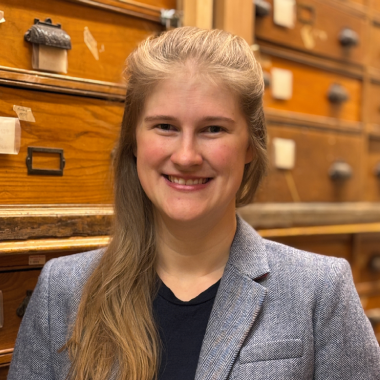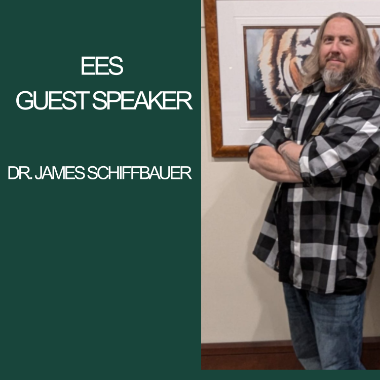Rusting Rock May Explain Two of Earth's Deepest Mysteries
Scientists have known about two of the most enormous and mysterious regions of the earth’s lower mantle, Large Low Shear Velocity Provinces (LLSVPs), for decades, but no one knows what they are made of or where they came from.

Michigan State University experimental geologist Susannah Dorfman and a talented team of international researchers pieced together a way to make an iron-rich form of the mineral bridgmanite—a rusting rock—that may explain the existence of LLSVPs.
The experimental study, published in Nature Communications, combined high pressure-temperature experiments with computational techniques and geodynamic simulations.
“One of the ideas is that when the earth originally crystallized, there was a residue of dense goo at the base of the mantle that has never been able to mix in,” said Dorfman, assistant professor in the Department of Earth and Environmental Sciences in the College of Natural Science who led the study. “Our experiment is about testing the major hypothesis that the LLSVPs are thermochemical piles—warm and soft and with a different chemical composition than the mantle material around them.”
Dorfman has been studying bridgmanite, thought to be the main component of the earth’s mantle, since she was a Ph.D. candidate at Princeton University. Her experiments involved dissolving different elements into bridgmanite to change its physical properties and see if that would help to explain the LLSVPs’ ability to stay distinct.

“I hired Jiachao Liu as my first postdoc at MSU, and one of the first things we decided to do was experiment with bridgmanite that has oxidized iron in it,” said Dorfman.
Liu, co-author of the paper, synthesized the “rusting” bridgmanite in a multi-anvil press in Jie Li’s lab at the University of Michigan. Li is also a co-author. They anticipated a suite of further experiments, but they ran into a problem. Instead of dissolving into bridgmanite, the oxidized iron stayed distinct, a big surprise to Dorfman and Liu.
“In order to further understand the results, we conducted a series of experiments to reproduce these observations and determine the crystalline structures of the coexisting silicates,” Liu said. “It turns out that both minerals adopt perovskite structure under the lower-mantle pressure and temperature conditions.”
“This meant there was some realistic composition of iron-rich bridgmanite that would crystallize out when the earth was forming and take the iron with it,” Dorfman added. “We had found a realistic way of generating this new, dense rock that would then sink to the bottom of the mantle.”
Had they stumbled onto a possible structure for the mysterious LLSVPs?
They asked a team of scientists to put their rusting rock to the test—several tests, in fact. First, Dorfman and Liu needed to know if the speed of seismic waves through the iron-rich bridgmanite matched those of the LLSVPs. In other words, did their seismic signatures match?

“Our calculations demonstrated that the newly discovered Fe3+-bearing bridgmanite had low sound velocities at lower-mantle conditions that can well explain the observed features of the Large Low Shear Velocity Provinces,” confirmed Wenzhong Wang, mineral physicist at University College London who collaborated on the study as a Ph.D. student at the University of Science and Technology of China.
The scientists then wanted to understand how it might behave under the temperature and pressure conditions at the lower mantle where the LLSVPs are known to exist. Would it ride mantle convection currents like blobs in a lava lamp, or stay on the bottom of the mantle-core boundary like crystallized honey at the bottom of a honey jar?

Mingming Li, assistant professor of geodynamics at Arizona State University, performed advanced computational simulations and found that the iron-rich bridgmanite could, in fact, sink to the base of the mantle and remain distinct like the LLSVPs.
Even more intriguing, Li’s images revealed tiny wisps of material that occasionally escaped from the defined edges of the LLSVPs into mantle circulation. These wisps may be the key to another mystery about an unidentified source of unearthly material spewed from volcanoes that line up with LLSVP edges.
“A long-standing issue in Earth’s interior science is that we have some types of volcanoes on Earth that seem to have little wisps of something ancient,” Dorfman explained. “There must be something different down there—chemical elements trapped since the beginning of the earth’s formation—and maybe that something different has been there throughout Earth’s history.”
If the LLSVPs have been the source for these volcanoes’ wisps of material for hundreds of millennia, they must be both ancient and impervious to the mantle’s thermal convection currents—and the dense, rusting rock created by Dorfman and Liu could just fit the description.
Other co-authors on the paper include Feng Zhu from the University of Michigan’s Department of Earth and Environmental Sciences and Zhongqing Wu from the University of Science and Technology of China.
Banner image: This image from Mingming Li’s computer simulation model shows intrinsically dense materials being accumulated into blobs (orange) at the bottom of the model, like the LLSVPs at the bottom of Earth’s mantle. Wisps of materials from the blobs are carried up to shallower depths, which may eventually be sampled in the source of volcanoes. Credit: Mingming Li



